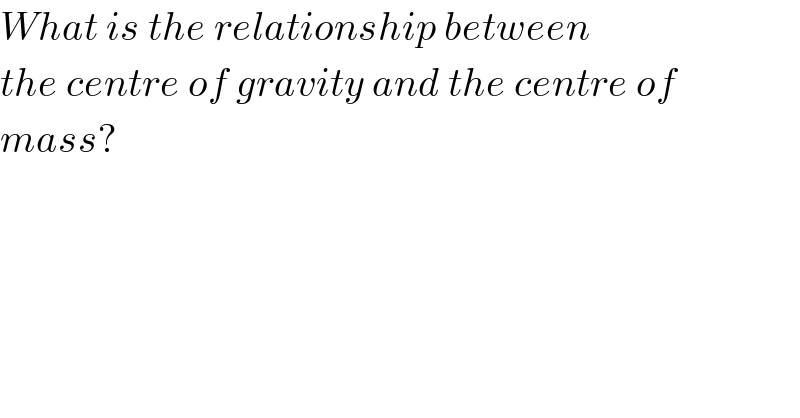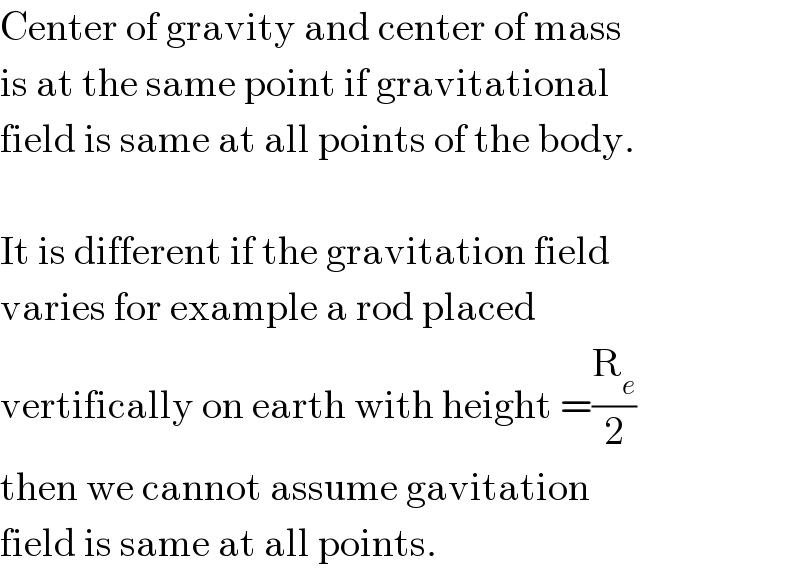Question Number 27326 by NECx last updated on 05/Jan/18

$${What}\:{is}\:{the}\:{relationship}\:{between} \\ $$$${the}\:{centre}\:{of}\:{gravity}\:{and}\:{the}\:{centre}\:{of} \\ $$$${mass}? \\ $$
Answered by prakash jain last updated on 05/Jan/18

$$\mathrm{Center}\:\mathrm{of}\:\mathrm{gravity}\:\mathrm{and}\:\mathrm{center}\:\mathrm{of}\:\mathrm{mass} \\ $$$$\mathrm{is}\:\mathrm{at}\:\mathrm{the}\:\mathrm{same}\:\mathrm{point}\:\mathrm{if}\:\mathrm{gravitational} \\ $$$$\mathrm{field}\:\mathrm{is}\:\mathrm{same}\:\mathrm{at}\:\mathrm{all}\:\mathrm{points}\:\mathrm{of}\:\mathrm{the}\:\mathrm{body}. \\ $$$$ \\ $$$$\mathrm{It}\:\mathrm{is}\:\mathrm{different}\:\mathrm{if}\:\mathrm{the}\:\mathrm{gravitation}\:\mathrm{field} \\ $$$$\mathrm{varies}\:\mathrm{for}\:\mathrm{example}\:\mathrm{a}\:\mathrm{rod}\:\mathrm{placed} \\ $$$$\mathrm{vertifically}\:\mathrm{on}\:\mathrm{earth}\:\mathrm{with}\:\mathrm{height}\:=\frac{\mathrm{R}_{{e}} }{\mathrm{2}} \\ $$$$\mathrm{then}\:\mathrm{we}\:\mathrm{cannot}\:\mathrm{assume}\:\mathrm{gavitation} \\ $$$$\mathrm{field}\:\mathrm{is}\:\mathrm{same}\:\mathrm{at}\:\mathrm{all}\:\mathrm{points}. \\ $$
Commented by mrW1 last updated on 06/Jan/18
![I try to calculate. M = mass of earth R = radius of earth m = mass of rod (vertically placed) L = length of rod x_G =position of CoG dm=(m/L)dx F=∫((GMdm)/((R+x)^2 ))=((GMm)/L)∫_0 ^( L) (dx/((R+x)^2 )) =((GMm)/L)[−(1/(R+x))]_0 ^L =((GMm)/L)[(1/R)−(1/(R+L))] =((GMm)/(R(R+L))) F×x_G =∫((xGMdm)/((R+x)^2 ))=((GMm)/L)∫_0 ^( L) ((xdx)/((R+x)^2 )) =((GMm)/L)[(R/(R+x))+ln (R+x)]_0 ^L =((GMm)/L)[(R/(R+L))−1+ln ((R+L)/R)] =((GMm)/L)[−(L/(R+L))+ln ((R+L)/R)] ((GMm)/(R(R+L)))×x_G =((GMm)/L)[−(L/(R+L))+ln ((R+L)/R)] ⇒x_G =((R(R+L))/L)[−(L/(R+L))+ln ((R+L)/R)] ⇒(x_G /L)=((R(R+L))/L^2 )[−(L/(R+L))+ln ((R+L)/R)] let λ=(L/R) or L=λR ⇒(x_G /L)=((R(R+λR))/(λ^2 R^2 ))[−((λR)/(R+λR))+ln ((R+λR)/R)] ⇒(x_G /L)=(((1+λ))/λ^2 )[−(λ/(1+λ))+ln (1+λ)] ⇒(x_G /L)=(((1+λ)ln (1+λ)−λ)/λ^2 )=α ⇒x_G =α L α is not a constant and α<(1/2) ⇒x_G <(L/2) but x_M =(L/2) it means the CoG lies lower than the CoM.](https://www.tinkutara.com/question/Q27414.png)
$${I}\:{try}\:{to}\:{calculate}. \\ $$$${M}\:=\:{mass}\:{of}\:{earth} \\ $$$${R}\:=\:{radius}\:{of}\:{earth} \\ $$$${m}\:=\:{mass}\:{of}\:{rod}\:\left({vertically}\:{placed}\right) \\ $$$${L}\:=\:{length}\:{of}\:{rod} \\ $$$${x}_{{G}} ={position}\:{of}\:{CoG} \\ $$$${dm}=\frac{{m}}{{L}}{dx} \\ $$$${F}=\int\frac{{GMdm}}{\left({R}+{x}\right)^{\mathrm{2}} }=\frac{{GMm}}{{L}}\int_{\mathrm{0}} ^{\:{L}} \frac{{dx}}{\left({R}+{x}\right)^{\mathrm{2}} } \\ $$$$=\frac{{GMm}}{{L}}\left[−\frac{\mathrm{1}}{{R}+{x}}\right]_{\mathrm{0}} ^{{L}} \\ $$$$=\frac{{GMm}}{{L}}\left[\frac{\mathrm{1}}{{R}}−\frac{\mathrm{1}}{{R}+{L}}\right] \\ $$$$=\frac{{GMm}}{{R}\left({R}+{L}\right)} \\ $$$${F}×{x}_{{G}} =\int\frac{{xGMdm}}{\left({R}+{x}\right)^{\mathrm{2}} }=\frac{{GMm}}{{L}}\int_{\mathrm{0}} ^{\:{L}} \frac{{xdx}}{\left({R}+{x}\right)^{\mathrm{2}} } \\ $$$$=\frac{{GMm}}{{L}}\left[\frac{{R}}{{R}+{x}}+\mathrm{ln}\:\left({R}+{x}\right)\right]_{\mathrm{0}} ^{{L}} \\ $$$$=\frac{{GMm}}{{L}}\left[\frac{{R}}{{R}+{L}}−\mathrm{1}+\mathrm{ln}\:\frac{{R}+{L}}{{R}}\right] \\ $$$$=\frac{{GMm}}{{L}}\left[−\frac{{L}}{{R}+{L}}+\mathrm{ln}\:\frac{{R}+{L}}{{R}}\right] \\ $$$$\frac{{GMm}}{{R}\left({R}+{L}\right)}×{x}_{{G}} =\frac{{GMm}}{{L}}\left[−\frac{{L}}{{R}+{L}}+\mathrm{ln}\:\frac{{R}+{L}}{{R}}\right] \\ $$$$\Rightarrow{x}_{{G}} =\frac{{R}\left({R}+{L}\right)}{{L}}\left[−\frac{{L}}{{R}+{L}}+\mathrm{ln}\:\frac{{R}+{L}}{{R}}\right] \\ $$$$\Rightarrow\frac{{x}_{{G}} }{{L}}=\frac{{R}\left({R}+{L}\right)}{{L}^{\mathrm{2}} }\left[−\frac{{L}}{{R}+{L}}+\mathrm{ln}\:\frac{{R}+{L}}{{R}}\right] \\ $$$${let}\:\lambda=\frac{{L}}{{R}}\:{or}\:{L}=\lambda{R} \\ $$$$\Rightarrow\frac{{x}_{{G}} }{{L}}=\frac{{R}\left({R}+\lambda{R}\right)}{\lambda^{\mathrm{2}} {R}^{\mathrm{2}} }\left[−\frac{\lambda{R}}{{R}+\lambda{R}}+\mathrm{ln}\:\frac{{R}+\lambda{R}}{{R}}\right] \\ $$$$\Rightarrow\frac{{x}_{{G}} }{{L}}=\frac{\left(\mathrm{1}+\lambda\right)}{\lambda^{\mathrm{2}} }\left[−\frac{\lambda}{\mathrm{1}+\lambda}+\mathrm{ln}\:\left(\mathrm{1}+\lambda\right)\right] \\ $$$$\Rightarrow\frac{{x}_{{G}} }{{L}}=\frac{\left(\mathrm{1}+\lambda\right)\mathrm{ln}\:\left(\mathrm{1}+\lambda\right)−\lambda}{\lambda^{\mathrm{2}} }=\alpha \\ $$$$\Rightarrow{x}_{{G}} =\alpha\:{L} \\ $$$$\alpha\:{is}\:{not}\:{a}\:{constant}\:{and}\:\alpha<\frac{\mathrm{1}}{\mathrm{2}} \\ $$$$\Rightarrow{x}_{{G}} <\frac{{L}}{\mathrm{2}} \\ $$$${but}\:{x}_{{M}} =\frac{{L}}{\mathrm{2}} \\ $$$${it}\:{means}\:{the}\:{CoG}\:{lies}\:{lower}\:{than} \\ $$$${the}\:{CoM}. \\ $$
Commented by NECx last updated on 05/Jan/18

$${thanks}\:{boss} \\ $$
